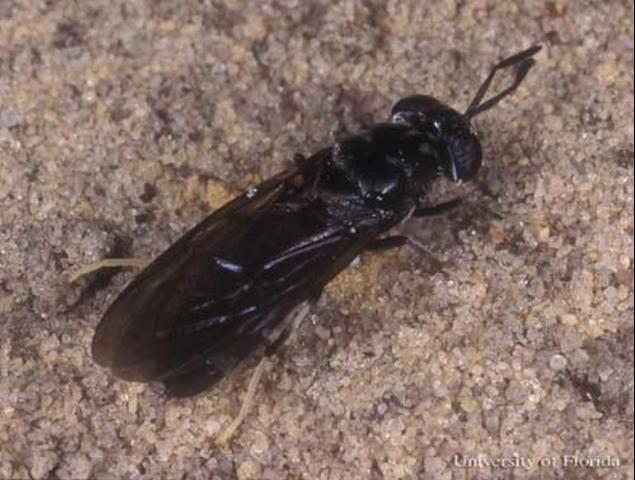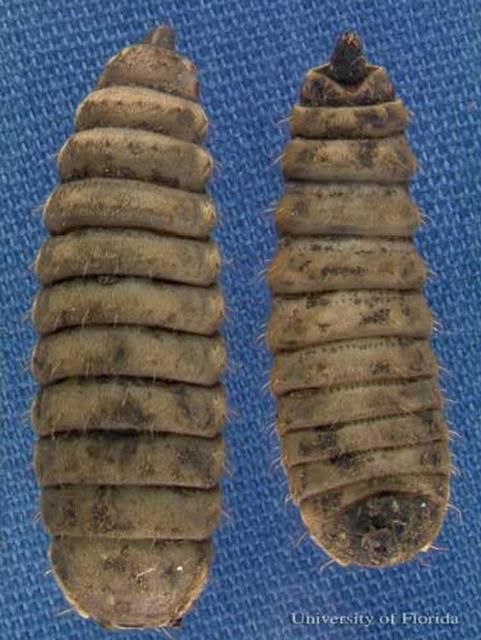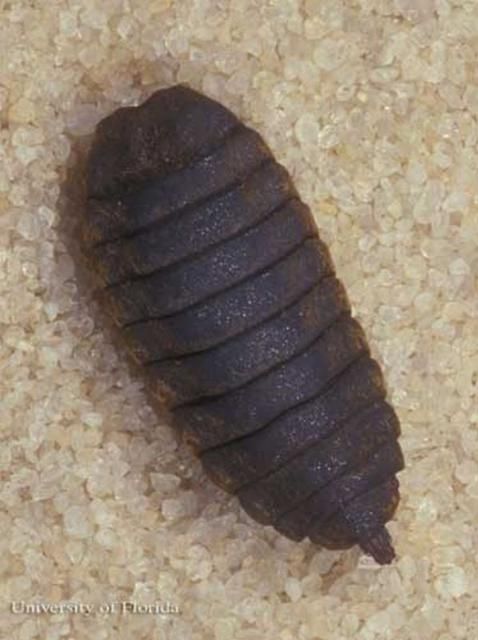The Featured Creatures collection provides in-depth profiles of insects, nematodes, arachnids and other organisms relevant to Florida. These profiles are intended for the use of interested laypersons with some knowledge of biology as well as academic audiences.
Introduction
The black soldier fly, Hermetia illucens (Linnaeus), is a sleek looking fly that many confuse with a wasp. However, like most flies, the black soldier flies only have two wings (wasps have four) and does not possess a stinger. Although the loud buzzing they create when flying is enough to concern many people, adult soldier flies pose no danger.

Credit: Lyle J. Buss, University of Florida
The black soldier fly is often associated with the outdoors and livestock, usually around decaying organic matter such as animal waste or plant material. Since the black soldier fly larvae consumes decaying matter, they have been used to reduce animal manure in commercial swine and poultry facilities (Newton 2005). Although they are not known as a disease vector, adult soldier flies are a potential mechanical vector of various pathogens. A more likely negative interaction would be accidental ingestion of black soldier fly larvae by animals or humans (Goddard 2003).
Synonymy
Musca illucens Linnaeus (1758)
Musca leucopa Linnaeus (1767)
Hermetia rufiventris Fabricius (1805)
Hermetia pellucens Macquart (1834)
Hermetia nigrifacies Bigot (1879)
Hermetia mucens Riley & Howard (1889)
Hermetia illucens var. nigritibia Enderlein (1914)
Hermetia illucens Copello (1926)
List generated from (ITIS 2009)
Distribution
The family Stratiomyidae comprises 260 known species in North America (Triplehorn 2005). In the southeastern United States, the black soldier fly is abundant during late spring and early fall, and has three generations per year in Georgia (Tomberlin et al. 2002). While common in the continental United States, this fly is found throughout the Western Hemisphere.
In natural breeding sites (i.e., carrion) black soldier flies lay their eggs in moist organic material. Black soldier flies frequent agricultural settings because the large amounts of organic waste left by livestock offer abundant sites that meet their reproductive needs. In areas where natural habitats are removed (urbanized areas) the black soldier fly will lay eggs in dumpsters or compost, which provide similar odors and nutritional needs to naturally occurring organic matter. This is especially true for areas with poor sanitation.
Description and Life Cycle
Adults
Members of the soldier fly family Stratiomyidae can range in color from yellow, green, black or blue, with some having a metallic appearance. Many are mimics of other flying insects, such as bees and wasps. Black soldier fly adults have a wasp-like appearance and are black or blue in color. Soldier flies also have two translucent "windows" located on the first abdominal segment. Adults range from 15 to 20 mm (2/3–¾ in) in length (Sheppard et al. 2002). The adult's antennae are elongated with three segments, and legs have white coloration near the end of each leg.

Credit: Bianca Diclaro, University of Florida
Two days after adult emergence from the pupal case, mating can occur. A male black soldier fly intercepts a passing female in mid-air and they descend in copula (Tomberlin and Sheppard 2001). Male soldier flies utilize lekking sites, where they await female soldier flies. These sites are defended against other male soldier flies. When a male intrudes upon the territory of a resting male, the resting male seizes the intruder. After a brief descent, the invading male will retreat.
Eggs
The female black soldier fly deposits a mass of about 500 eggs in cracks and crevices near or in decaying matter such as dung, carrion, garbage, and other organic waste. The eggs hatch into larvae in about four days. Each oval shaped egg is about 1 mm (< 1/16 in) in length, and pale yellow or creamy white in color (NCIPMI 1998).
Larvae
The larvae can reach 27 mm (1 in) in length and 6 mm (1/4 in) in width. They are a dull, whitish color with a small, projecting head containing chewing mouthparts. Larvae pass through six instars and require approximately 14 days to complete development (Hall and Gerhardt 2002). During larval development, black soldier fly larvae are insatiable feeders. As adults they do not need to feed and rely on the fats stored from the larval stage (Newton et al. 2005).

Credit: Bianca Diclaro, University of Florida
Pupae
Before pupation, the sixth instar larvae disperse from the feeding site to dry sheltered areas, such as ground vegetation, to initiate pupation. The exoskeleton (skin) darkens, and a pupa develops within. Pupation requires about two weeks (Hall and Gerhardt 2002).

Credit: James Castner, University of Florida
Economic Importance
The adult black soldier fly is not usually considered a pest (Newton et al. 2005). Because the larvae have been shown to be effective manure recyclers, a "Black Soldier Fly Manure Management System" has been proposed to not only reduce livestock waste, but also generate a food source for fish and other animals. In a program outlined in Newton et al. (2005) swine manure was fed to black soldier fly larvae, which greatly reduced the waste material. The manure was transferred into a basin containing black soldier fly larvae. As the larvae developed, they reduced the manure by 50%. Approximately 45,000 larvae will consume 24 kg (53 lb) of swine manure in 14 days. As the larvae mature they crawl out of the basin, thereby self-harvesting themselves, and are subsequently available as livestock feed. In addition to being a good source of oil and protein for animal feed, black soldier fly larvae have the potential of improving organic waste into a rich fertilizer.

Credit: Lyle J. Buss, University of Florida
Selected References
Goddard, J. 2003. Physician's Guide to Arthropods of Medical Importance, 4th Edition. CRC Press LLC. Boca Raton, Florida.
Hall DC, Gerhardt RR. 2002. Flies (Diptera), pp 127-161. In Mullen G, Durden L. (editors). Medical and Veterinary Entomology. Academic Press. San Diego, California.
ITIS. (2009). Hermetia illucens Linnaeus. Integrated Taxonomic Information System. https://www.itis.gov/servlet/SingleRpt/SingleRpt?search_topic=TSN&search_value=130298#null (25 February 2022).
NCIPMI. (1998). Insect and other pests of people and animals: some important, common, and potential pests in the Southeastern United States. North Carolina State University Cooperative Extension Service Agricultural Publication 369, revised. https://d.lib.ncsu.edu/collections/catalog/ua102_200-003-bx0083-026-001#?c=&m=&s=&cv=&xywh=-2519%2C-236%2C8734%2C5179. (7 June 2021).
Newton L, Sheppard C, Watson DW, Burtle G, Dove, R. (June 2005). Using the black soldier fly, Hermetia illucens, as a value-added tool for the management of swine manure. Waste Management Programs. North Carolina State University. https://projects.ncsu.edu/cals/waste_mgt/smithfield_projects/phase2report05/cd,web%20files/A2.pdf. (7 June 2021).
Sheppard DC, Tomberlin JK, Joyce JA, Kiser BC, Sumner SM. 2002. Rearing methods for the black soldier fly (Diptera: Stratiomyidae). Journal of Medical Entomology 39: 695–698.
Tomberlin JK, Sheppard DC. 2001. Lekking behavior of the black soldier fly (Diptera: Stratiomyidae). Florida Entomologist 84: 729-730.
Tomberlin JK, Sheppard DC, Joyce JA. 2002. Selected life history traits of black soldier flies (Diptera: Stratiomyidae) reared on three artificial diets. Annals of the Entomological Society of America 95: 379–386.
Triplehorn CA, Johnson NF. 2005. Borror and Delong's Introduction to the Study of Insects, 7th Edition. Thomson Brooks/Cole. Belmont, California. 864 pp.